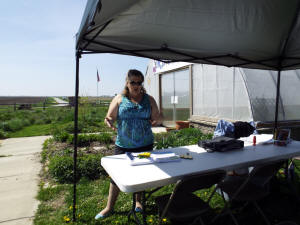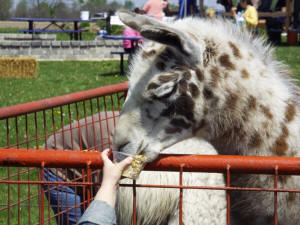|
 The Center was hosting a special Earth Day celebration that
included activities for children and adults, a petting zoo, food,
and live music provided by the Lincoln College String Ensemble. The Center was hosting a special Earth Day celebration that
included activities for children and adults, a petting zoo, food,
and live music provided by the Lincoln College String Ensemble.
As guests arrived, the first thing to catch their eye might have
been a tent set up outside the Creekside Insectarium. Kim Wiggers de
Otte was set up with copies of the Rotary Insectarium Coloring Book,
crayons, and colored pencils. Children and adults alike were invited
to take up a crayon and color pictures in the books. The children
could also take their book home when them to enjoy later.

On the other side of her tent, an LC student was helping children
create Gorilla Seed Balls. This was a fun and interesting activity
again where parents could also participate. The seed balls are made
of a rich potting mix, potters clay, and a selection of wildflower
seeds. Children could combine the ingredients and roll it into
balls. They were then encouraged to drop the balls onto a tilled
garden plot where they will eventually grow into a beautiful patch.
Wiggers de Otte is a huge fan of Creekside and talked
enthusiastically about what goes on at the center and also about the
future. She noted that the wooden walkways that are present in the
native grass areas were the product of the Lincoln Rotary. She said
the Rotary has committed to building more boardwalks in the future
and has a goal of eventually having the boardwalk all the way out to
the wooded area of the Center.

She’s also excited about the future of the center and the plans to
bring history alive through homestead replicas, and Native American
Villages. Wiggers de Otto explained that on the path from the park
like setting of the center back to the wooded area and Sugar Creek,
there will be replica settlements erected. She said closest to the
park area there will be a cabin built that will represent the
settlers who came to the area many years ago. From the cabin to the
creek will be a walk backward through time as guests will be able to
see Tee-pee villages common to the most recent American Indian
settlements. Further down the path, guests will see examples of the
Indian villages that were occupied by earlier tribes, and
eventually, as visitors work their way toward the creek, they will
experience the lifestyle and habitat of prehistoric man in this
region.

Spring is an exciting time of year at Creekside, as plants come out
of their winter rest and begin their growing cycle. This past
weekend, the native plants that are abundant at the center are in
their early stages of growth. Guests could appreciate the landscape
and catch sight of the blue bird houses that are strategically
placed in the prairie grass plot on the center’s south side.
Inside the Insectarium, plants are also coming alive and reviving.
Right now there aren’t many insects or butterflies to see, but as
the summer progresses, visitors should return and take it all in
again.
Moving away from the insectarium and into the pavilion area, there
were several tents and tables set up with activities meant to be fun
and educational.

Among those displays, a bone guessing game where an actual Mastodon
tooth fossil was on display. The tooth is one of the fossils that
was discovered in the Creekside area.
[to top of second column] |

Other guessing games included identifying animal tracks and a
shell identification game. There were also displays of various
“arrow heads.” These are stones which in primitive times would
have been chipped out of stone and shaped to use as a weapon for
hunting game.
Under the pavilion, visitors had an opportunity to take home a
tree for planting in their yard, admire primitive-style wood
carving, choose a free gardening book or two, build a bluejay
house, or paint a pet rock.
 Out on the green grass, the Logan
County Railsplitting Association was also on hand sharing
information about the log splitting festival that is held each fall
in Lincoln at the Logan County Fairground. They were also working to
get the word out that this year, the Civil War Ball held in
conjunction with the Festival will take place in just two weeks, on
May 6th, at the American Legion in Lincoln.
At noon time, the Lincoln College String Ensemble arrived and set up
for live music around the fire pit area. Picnic tables and straw
bales were scattered in the grassy area, and visitors could purchase
a hamburger or cheeseburger with chips for a quick lunch.

On the far edge of the park-like area, a petting zoo was set up that
featured a wide variety of little animals that were a delight for
young and old alike. Visitors also had the opportunity to scoop up a
cup of food and feed the animals.
The walking path to Sugar Creek was also available for those who
wanted to work off their lunch and enjoy the woodland and the creek.

Throughout the day, Dr. Dennis Campbell of Lincoln College was busy
visiting with guests and making sure all was going well at the
various stations set up throughout the center. Dr. Campbell is the
force behind the Center, working diligently to keep it up, grow it,
and share it with LC students and the public.
According to the visitor guide being passed out on Saturday,
Creekside is open to the public seven days a week, 365 days of the
year, from dawn to dusk. Visitors are encouraged to come out and
enjoy the Center at any time and are also asked to respect the
Center and its intended purpose. It is okay to build a fire in the
fire pit or the brick barbecue, but please be sure all fires are
properly extinguished before leaving the property. It is not okay to
take plants or other property away from the site.
The public is also invited to be a part of the process through
volunteering their time to the preservation and expansion of the
native setting. To learn more about volunteer opportunities, contact
Dr. Campbell at 217-735-7260.
[Nila Smith]
 |